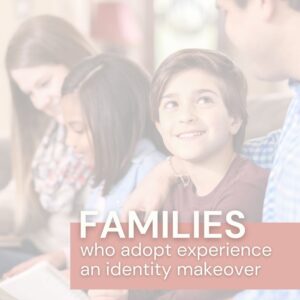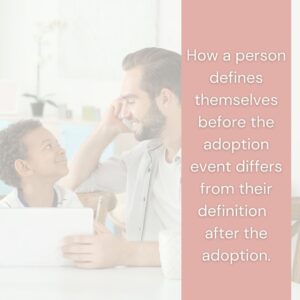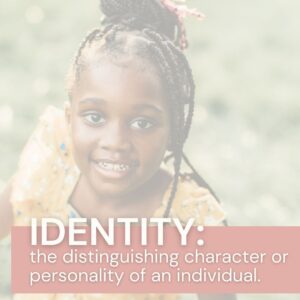How do you know who you are? For many, the definitions of identity we build inside ourselves are created from our experiences. Charity Gayle wrote a song, “There is a New Name Written Down in Glory,” saying, “I am who I am because the I Am tells me who I am.” The question for many is, what does that definition of identity look like, especially as we try to recover our identity after adoption?
Christians automatically respond with the answer, “God is my “I Am,” and His opinion defines me.” However, what about those who have come from a hard place in life? What kind of definition do they have? Where might they learn to define their identity in this world? People who have experienced dysfunctional living may not have a grounded and safe definition of their identity. Survival skills may have defined their identity. How a person perceives themselves in the world around them greatly affects their ability to have self-acceptance and self-confidence.

Families who have adopted generally experience an identity makeover. Each family member may find that their perspective changes after an adoption. An individual’s definitions of who they are and their role in the world may begin to be challenged or redefined. When these definitions are changed or are not accomplished, it can create chaos in identity that affects how a person views themselves and others. Suppose a person is not able to accept themselves as being safe and ok in their own skin. In that case, that person may feel some confusion or chaos about who they are as a person. Likewise, if a person knows what they want to be good at doing and are not able to accomplish that, they may experience low self-confidence.
The challenge for families who have experienced foster or adoption is that how a person defined themselves before the foster/adoption event differs from the definition that works after the adoption. There is a transition period for this identity transformation. Parents and children become aware that how they did family events, holidays, and vacations before the adoption is very different after the adoption. Yearly triggers, seasonal behaviors, and overstimulating environments quickly result in a family looking differently than other families around them.
Children who have received foster or adoption services may experience a radically different house, daily routine, family, school, or socioeconomic lifestyle change. Each person’s ability to adjust and tolerate these changes depends on their definition and expectation for that moment. Their ability to stay grounded and have a healthy definition of themselves and the world around them is important. People who have experienced adoption are changed by the adoption experience. Their identity definitions change, expectations for life events change, and their definitions of success change.

As you would expect, recovering identity after adoption is an individual process. People may see outward behaviors that indicate internal chaos. Or we may see evidence of internal chaos through signs of depression, anxiety, behavioral outbursts, or withdrawal from activities. Generally, when people struggle to define themselves and their role in the world, they will be confused and chaotic in how they connect with others. Sometimes it may appear that a person is frequently trying on a different look, personality, or worldview point. Their boundaries with others may be very firm or nonexistent. When trying to evaluate if there is an identity struggle, notice the chaos and inconsistency.
When it comes to building identity and self-confidence after adoption, think about communication skills. Remember, trauma causes the brain to process information differently and often does not use words to survive. The lack of words causes behaviors. When parents try to help their children adjust to their new life, allowing them space to find their words is essential.
Self-confidence is built by being successful at something at which you want to be successful. Success is particularly important when it comes to children who have been adopted. Don’t expect an adopted child to want the same identity as your family. Be aware of a child’s interest, especially if it’s something related to a birth family. For some children, maintaining traditions they enjoyed in the birth family may be essential to continue. For example, these traditions may include a particular type of food, sport, or a yearly event.
Also, be aware of cultural identity perceptions that may exist. Every town and city is different in how they address the issue of different cultures, and it can be a highly sensitive subject. No matter what opinion people may have on cultural acceptance, please consider how to help your child feel comfortable in their own skin and to use their own voice.
I have had several children who are transracially adopted. Transracial adoption means the parents and children are from different cultural backgrounds and may have different skin color appearance. Parents try to accept children into their families with minimal adaptations for cultural differences. It is essential to have inclusion without separation of culture. It is equally important to include culture in identity, especially in foster to adopt situations where children may be used to living in a family with different daily cultural routines. Notice when cultural differences make a child feel uncomfortable or “different.” All cultures deserve to be valued and acknowledged. Parents are encouraged to learn about different cultures and discuss how cultural identity affects the family and each person individually. Empowerment can occur when children are exposed to cultural definitions.
Some children, teenagers, and young adults are quiet and don’t socialize much due to different responses they have received from strangers and well-meaning family friends. Several of these kids have stories of strangers expecting them not to speak English or asking them questions about their assumed adoption trauma, to which they have no answers. Or people from the same ethnic background assume they speak a native language due to a person’s cultural appearance.
I have one teenager who was born and raised in America but physically appears Hispanic. She talks about how it’s easier for her to go shopping by herself than with her family because people assume she doesn’t speak English when she is with her family. Or, people ignore her entirely and talk directly to her parents. She talks about how uncomfortable it is for both her and her parents.
Children are often embarrassed to correct people and choose not to talk. A lack of words can lead to behavioral outbursts or withdrawal from the family. I encourage parents to talk with their children about what would make them feel safe around people who are uneducated about adoption and cultural issues. Don’t be afraid to educate others so your child does not have to. However, the priority should be ensuring your children are not embarrassed by your response. This is a balancing act that often takes practice and time to learn as a family.

Webster’s Dictionary defines identity as “the distinguishing character or personality of an individual.” I believe God created each person with an original and unique body, mind, and spirit. That means no one who came before you or after you will be exactly like you. The goal for a healthy attachment cycle is to know your needs, verbally express those needs, and allow those needs to be met “enough” to be safe and satisfied so that you will trust yourself first and then others. This is the journey to knowing your identity as God created in you a “good work” (Philippians 1:6) and helping you recover identity after adoption.
The post Recovering Identity After Adoption appeared first on Focus on the Family.
Continue reading...
Christians automatically respond with the answer, “God is my “I Am,” and His opinion defines me.” However, what about those who have come from a hard place in life? What kind of definition do they have? Where might they learn to define their identity in this world? People who have experienced dysfunctional living may not have a grounded and safe definition of their identity. Survival skills may have defined their identity. How a person perceives themselves in the world around them greatly affects their ability to have self-acceptance and self-confidence.

Families who have adopted generally experience an identity makeover. Each family member may find that their perspective changes after an adoption. An individual’s definitions of who they are and their role in the world may begin to be challenged or redefined. When these definitions are changed or are not accomplished, it can create chaos in identity that affects how a person views themselves and others. Suppose a person is not able to accept themselves as being safe and ok in their own skin. In that case, that person may feel some confusion or chaos about who they are as a person. Likewise, if a person knows what they want to be good at doing and are not able to accomplish that, they may experience low self-confidence.
The Identity Challenge
The challenge for families who have experienced foster or adoption is that how a person defined themselves before the foster/adoption event differs from the definition that works after the adoption. There is a transition period for this identity transformation. Parents and children become aware that how they did family events, holidays, and vacations before the adoption is very different after the adoption. Yearly triggers, seasonal behaviors, and overstimulating environments quickly result in a family looking differently than other families around them.
Children who have received foster or adoption services may experience a radically different house, daily routine, family, school, or socioeconomic lifestyle change. Each person’s ability to adjust and tolerate these changes depends on their definition and expectation for that moment. Their ability to stay grounded and have a healthy definition of themselves and the world around them is important. People who have experienced adoption are changed by the adoption experience. Their identity definitions change, expectations for life events change, and their definitions of success change.

What Does Recovering Identity After Adoption Look Like?
As you would expect, recovering identity after adoption is an individual process. People may see outward behaviors that indicate internal chaos. Or we may see evidence of internal chaos through signs of depression, anxiety, behavioral outbursts, or withdrawal from activities. Generally, when people struggle to define themselves and their role in the world, they will be confused and chaotic in how they connect with others. Sometimes it may appear that a person is frequently trying on a different look, personality, or worldview point. Their boundaries with others may be very firm or nonexistent. When trying to evaluate if there is an identity struggle, notice the chaos and inconsistency.
Build Communication Self-Confidence
When it comes to building identity and self-confidence after adoption, think about communication skills. Remember, trauma causes the brain to process information differently and often does not use words to survive. The lack of words causes behaviors. When parents try to help their children adjust to their new life, allowing them space to find their words is essential.
Self-confidence is built by being successful at something at which you want to be successful. Success is particularly important when it comes to children who have been adopted. Don’t expect an adopted child to want the same identity as your family. Be aware of a child’s interest, especially if it’s something related to a birth family. For some children, maintaining traditions they enjoyed in the birth family may be essential to continue. For example, these traditions may include a particular type of food, sport, or a yearly event.
Also, be aware of cultural identity perceptions that may exist. Every town and city is different in how they address the issue of different cultures, and it can be a highly sensitive subject. No matter what opinion people may have on cultural acceptance, please consider how to help your child feel comfortable in their own skin and to use their own voice.
Consider Cultural Identity
I have had several children who are transracially adopted. Transracial adoption means the parents and children are from different cultural backgrounds and may have different skin color appearance. Parents try to accept children into their families with minimal adaptations for cultural differences. It is essential to have inclusion without separation of culture. It is equally important to include culture in identity, especially in foster to adopt situations where children may be used to living in a family with different daily cultural routines. Notice when cultural differences make a child feel uncomfortable or “different.” All cultures deserve to be valued and acknowledged. Parents are encouraged to learn about different cultures and discuss how cultural identity affects the family and each person individually. Empowerment can occur when children are exposed to cultural definitions.
Children and Cultural Assumptions
Some children, teenagers, and young adults are quiet and don’t socialize much due to different responses they have received from strangers and well-meaning family friends. Several of these kids have stories of strangers expecting them not to speak English or asking them questions about their assumed adoption trauma, to which they have no answers. Or people from the same ethnic background assume they speak a native language due to a person’s cultural appearance.
I have one teenager who was born and raised in America but physically appears Hispanic. She talks about how it’s easier for her to go shopping by herself than with her family because people assume she doesn’t speak English when she is with her family. Or, people ignore her entirely and talk directly to her parents. She talks about how uncomfortable it is for both her and her parents.
Children are often embarrassed to correct people and choose not to talk. A lack of words can lead to behavioral outbursts or withdrawal from the family. I encourage parents to talk with their children about what would make them feel safe around people who are uneducated about adoption and cultural issues. Don’t be afraid to educate others so your child does not have to. However, the priority should be ensuring your children are not embarrassed by your response. This is a balancing act that often takes practice and time to learn as a family.

Identity Do’s and Don’t’s After Adoption
Do:
- Choose a relationship and seek to know each other’s wants, needs, hopes, and dreams.
- Allow for unique individuality.
- Notice when there is silence/withdrawal or attention-seeking behaviors.
- Seek to understand “the why.”
- Be open to your family having different needs than other families around you.
- Try to meet both people’s needs at the same time.
Don’t:
- Ignore what the child needs/wants and assume they will adjust.
- Stop listening because you don’t value what your child does at this moment.
- Assume you know how your child thinks or feels about something.
- Expect they will “get over it.”
- Think it’s a long-term value choice.
Webster’s Dictionary defines identity as “the distinguishing character or personality of an individual.” I believe God created each person with an original and unique body, mind, and spirit. That means no one who came before you or after you will be exactly like you. The goal for a healthy attachment cycle is to know your needs, verbally express those needs, and allow those needs to be met “enough” to be safe and satisfied so that you will trust yourself first and then others. This is the journey to knowing your identity as God created in you a “good work” (Philippians 1:6) and helping you recover identity after adoption.
The post Recovering Identity After Adoption appeared first on Focus on the Family.
Continue reading...





